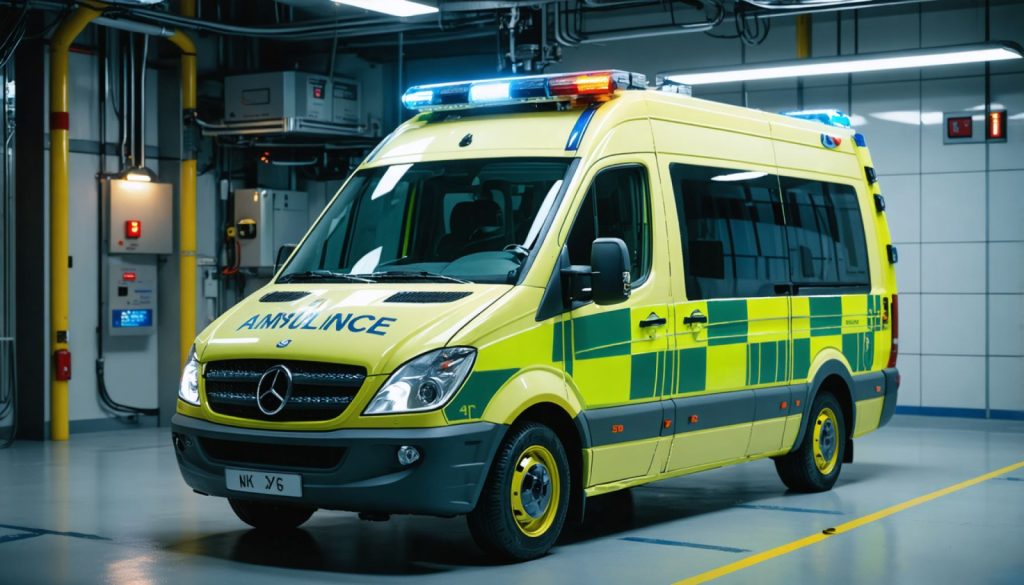
- Innovative connectivity technology is transforming emergency medical services in hospitals across the East of England.
- Signal-boosting devices have been installed in four hospitals: Peterborough City, Princess Alexandra in Harlow, Colchester, and Luton & Dunstable.
- This technology ensures reliable mobile and Wi-Fi connectivity, even in challenging architectural environments.
- Enhanced connectivity allows paramedics to seamlessly transfer critical data, improving clinical decision-making and patient outcomes.
- A recent NHS England review highlights the technology’s role in reducing clinical risks and enabling real-time care updates.
- The trial has increased staff morale and efficiency, leading to potential widespread adoption across more facilities.
- This advancement underscores the impact of technological adaptation in enhancing healthcare delivery.
The bustling hallways of hospitals are often quieted by the soft beeps of medical equipment and the hurried footsteps of paramedics. However, a silent revolution, carried in the form of small boxes, is transforming these corridors into nodes of enhanced connectivity and streamlined care. In a landscape where every second counts, the East of England Ambulance Service Trust (EEAST) trialed an innovative technology that is reshaping emergency medical services.
Four hospitals in England—Peterborough City, Princess Alexandra in Harlow, Colchester, and Luton & Dunstable—have become the proving grounds for this next-gen solution. These facilities installed advanced signal-boosting devices that ensure paramedics maintain a constant flow of information, even when architectural quirks threaten to sever digital ties. In an era where mobile signals and Wi-Fi connections are as temperamental as they are essential, this technology redefines reliability. Picture this: crews armed with seamless connectivity, navigating the mazes of metallic and lead-lined structures without a hitch.
Imaging ambulance crews seamlessly transferring critical data about end-of-life care and mental health plans as they sprint to the hospital bay. This isn’t just about technology; it’s about redefining clinical decision-making and enhancing patient outcomes. As signals drop less often and applications hold steady, paramedics can focus entirely on their patients, liberated from the technical shackles of the past.
The recent NHS England review of the technology underscores its significance. It’s not merely a matter of convenience; it’s a catalyst for reducing clinical risks and enabling real-time care updates. Frustrated with disconnects and delayed handovers, medical staff now have a system that sings in harmony with their urgent rhythms.
The trial has not only uplifted staff morale and efficiency but is also set to herald a widespread adoption across the region. As these devices find new homes in more facilities, ambulance trusts from different corners have caught the scent of transformative potential.
The tale here is one of adaptation and progress, a testament to how small steps in technology can lead to giant leaps in healthcare. The core takeaway echoes louder than ever: enhancing connectivity in critical environments doesn’t just keep teams on the road; it ferries critical care to those who need it fastest. In this dance between digital innovation and healthcare, every click, beep, and signal carries the promise of life-saving precision.
The Surprising Technology Revolutionizing Emergency Medical Services
Introduction
A quiet revolution is underway in hospitals across England, transforming the way emergency medical services are delivered. Thanks to advanced signal-boosting technology, paramedics from the East of England Ambulance Service Trust (EEAST) are now better connected, improving their ability to provide timely and effective care. This article explores the broader impact of this technology, delving into its benefits, use cases, and future prospects.
Unpacking the Innovation
The recent trial of signal-boosting devices in four English hospitals—Peterborough City, Princess Alexandra in Harlow, Colchester, and Luton & Dunstable—represents a significant step forward in emergency healthcare. These small yet powerful devices enhance mobile and Wi-Fi connectivity for paramedics, ensuring uninterrupted communication even in environments that typically hinder signals.
Additional Facts:
1. Signal-boosting Technology: The technology uses repeaters and signal amplifiers to strengthen mobile networks inside structures with dense materials like metal and concrete, which can block or weaken signals.
2. Clinical Outcome Impact: Improved connectivity has been correlated with faster decision-making processes and better adherence to treatment protocols.
3. Economic Benefits: By reducing patient transfer delays and improving incident response times, these devices can decrease overall healthcare costs.
How-To Steps & Life Hacks
Improving Hospital Connectivity:
1. Site Assessment: Evaluate the hospital design and materials to determine potential signal blockages.
2. Device Installation: Position signal-boosting devices strategically throughout the hospital to cover dead zones.
3. Regular Maintenance: Schedule routine checks to ensure devices are functioning optimally.
4. Staff Training: Educate medical staff on how to best utilize enhanced connectivity for patient care.
Real-World Use Cases
– Emergency Call Efficiency: Paramedics can receive and process emergency calls with minimal signal interference, reducing response times.
– Data Transfer for Critical Care: Seamless data transmission ensures critical patient information, such as end-of-life care directives and mental health plans, are always accessible.
Market Forecasts & Industry Trends
The drive for enhanced healthcare connectivity is set to grow, with analysts predicting a steady increase in the deployment of such technologies across hospitals worldwide. The adoption of 5G and IoT devices further bolsters this trend, enabling even faster data transfer speeds and enhanced device interoperability.
Reviews & Comparisons
Pros:
– Reliable and continuous signal strength.
– Improved patient data transfer capabilities.
– Enhanced staff morale and operational efficiency.
Cons:
– Initial setup and maintenance costs.
– Requires periodic updates to keep pace with emerging technologies.
Security & Sustainability
Security: Ensuring encrypted and secure connections is paramount to prevent unauthorized access to patient data transmitted over these enhanced networks.
Sustainability: Signal-boosting devices are designed to consume minimal energy and integrate seamlessly with existing hospital infrastructure, reducing their ecological footprint.
Quick Tips for Hospitals
– Prioritize Coverage Areas: Focus on critical zones like emergency rooms and intensive care units for device placement.
– Utilize Analytics: Analyze connectivity data to refine signal boosting locations and optimize network efficiency.
– Engage in Continuous Training: Keep staff updated on technology advancements to maximize benefits.
Conclusion
For hospitals aiming to enhance emergency medical services, investing in signal-boosting technologies offers a viable path to improved connectivity and patient outcomes. As these devices continue to gain traction, the healthcare industry stands on the brink of a connectivity-driven transformation. Explore more about healthcare advancements at England NHS and consider how this technology could revolutionize your emergency services.



